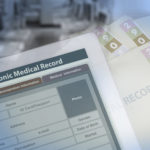By Peter J. Cass, OD

June 15, 2022
Do you know what information blocking is? New laws have been passed that make understanding what it is–and not doing it–important. Here are the details.
What Is It?
Information blocking is anything that interferes with, prevents or materially discourages access, exchange or use of electronic health information (EHI). The concept was defined by Congress in the 21st Century Cures Act, and the Office of the National Coordinator for Health Information Technology (ONC) is responsible for defining what does and doesn’t constitute data blocking. Like the Affordable Care Act, the Cures Act was hastily passed and includes many things that have nothing to do with the law’s original intent.
What Do I Need to Do?
Provisions in the Cures Act relating to information blocking are aimed at certified electronic health record (EHR) developers, health information exchanges and networks and providers. Most of the burden for compliance falls on the EHR developers, but every healthcare provider is bound by the requirements of the Cures Act to release all healthcare information to patients upon their request.
So, even though EHR vendors are supposed to make the information accessible easily and automatically (like the Cures Act wants), it is ultimately the provider’s responsibility to get any information the patient wants to the patient. For that reason, providers need to be aware of what constitutes information blocking and the exceptions that are allowed.
Other Articles to Explore
What Constitutes Information Blocking?
Section 4004 of the Cures Act specifies certain practices that could constitute information blocking:
• Practices that restrict authorized access, exchange or use of EHI
• Implementing health IT in nonstandard ways that are likely to substantially increase the complexity or burden of accessing, exchanging or using EHI;
• Excessive fees charged to create EHR interfaces or connections with other health information technology
• Limiting or restricting the interoperability of health IT, such as disabling or restricting the use of a capability that enables sharing EHI with users of other systems or
• Restricting access to EHI by certain types of persons
• Refusing to register a software application that enables patient access to their EHI
The Cures Act authorizes as reasonable and necessary some activities that do not constitute information blocking (provided certain conditions are met). These would include:
• Practices that are reasonable and necessary to prevent harm to a patient or another person
• To protect an individual’s privacy
• To protect the security of EHI
• Due to the infeasibility of the request
• To make health IT temporarily unavailable for the benefit of the overall performance of the health IT
• To limit the content or the manner in which it fulfills a request to access, exchange or use EHI
• To charge fees, including fees that result in a reasonable profit margin, for accessing, exchanging or using EHI.
• To license interoperability elements for EHI to be accessed, exchanged or used.
If many of these practices and exceptions seem highly technical, it is because most of them are aimed at EHR developers. However, optometrists should understand the basics of information blocking and do their best to provide electronic health information to their patients when requested.

Peter J. Cass, OD, is a partner in Practice Compliance Solutions, a faculty member for the University of Houston College of Optometry, an associate at MyEyeDr. Beaumont and past-president of the Texas Optometric Association. To contact: peter@PCScomply.com

























